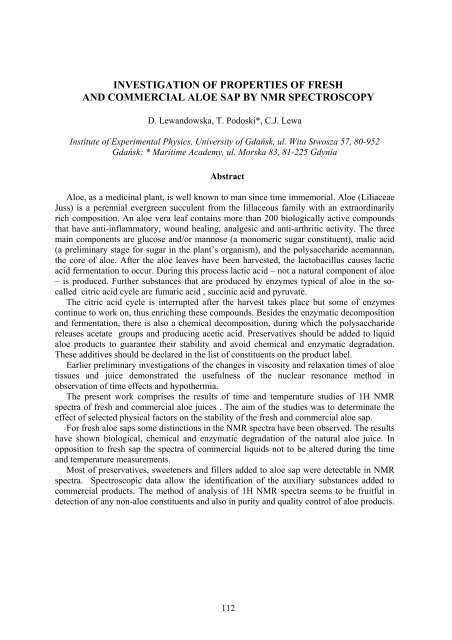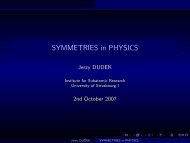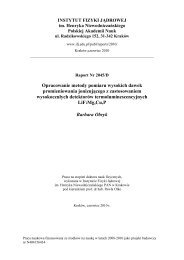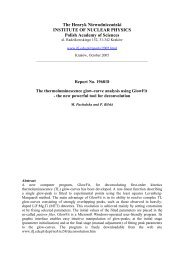Report No xxxx - Instytut Fizyki JÄ drowej PAN
Report No xxxx - Instytut Fizyki JÄ drowej PAN
Report No xxxx - Instytut Fizyki JÄ drowej PAN
Create successful ePaper yourself
Turn your PDF publications into a flip-book with our unique Google optimized e-Paper software.
INVESTIGATION OF PROPERTIES OF FRESH<br />
AND COMMERCIAL ALOE SAP BY NMR SPECTROSCOPY<br />
D. Lewandowska, T. Podoski*, C.J. Lewa<br />
Institute of Experimental Physics, University of Gdańsk, ul. Wita Stwosza 57, 80-952<br />
Gdańsk; * Maritime Academy, ul. Morska 83, 81-225 Gdynia<br />
Abstract<br />
Aloe, as a medicinal plant, is well known to man since time immemorial. Aloe (Liliaceae<br />
Juss) is a perennial evergreen succulent from the lillaceous family with an extraordinarily<br />
rich composition. An aloe vera leaf contains more than 200 biologically active compounds<br />
that have anti-inflammatory, wound healing, analgesic and anti-arthritic activity. The three<br />
main components are glucose and/or mannose (a monomeric sugar constituent), malic acid<br />
(a preliminary stage for sugar in the plant’s organism), and the polysaccharide acemannan,<br />
the core of aloe. After the aloe leaves have been harvested, the lactobacillus causes lactic<br />
acid fermentation to occur. During this process lactic acid – not a natural component of aloe<br />
– is produced. Further substances that are produced by enzymes typical of aloe in the socalled<br />
citric acid cycle are fumaric acid , succinic acid and pyruvate.<br />
The citric acid cycle is interrupted after the harvest takes place but some of enzymes<br />
continue to work on, thus enriching these compounds. Besides the enzymatic decomposition<br />
and fermentation, there is also a chemical decomposition, during which the polysaccharide<br />
releases acetate groups and producing acetic acid. Preservatives should be added to liquid<br />
aloe products to guarantee their stability and avoid chemical and enzymatic degradation.<br />
These additives should be declared in the list of constituents on the product label.<br />
Earlier preliminary investigations of the changes in viscosity and relaxation times of aloe<br />
tissues and juice demonstrated the usefulness of the nuclear resonance method in<br />
observation of time effects and hypothermia.<br />
The present work comprises the results of time and temperature studies of 1H NMR<br />
spectra of fresh and commercial aloe juices . The aim of the studies was to determinate the<br />
effect of selected physical factors on the stability of the fresh and commercial aloe sap.<br />
For fresh aloe saps some distinctions in the NMR spectra have been observed. The results<br />
have shown biological, chemical and enzymatic degradation of the natural aloe juice. In<br />
opposition to fresh sap the spectra of commercial liquids not to be altered during the time<br />
and temperature measurements.<br />
Most of preservatives, sweeteners and fillers added to aloe sap were detectable in NMR<br />
spectra. Spectroscopic data allow the identification of the auxiliary substances added to<br />
commercial products. The method of analysis of 1H NMR spectra seems to be fruitful in<br />
detection of any non-aloe constituents and also in purity and quality control of aloe products.<br />
112

















